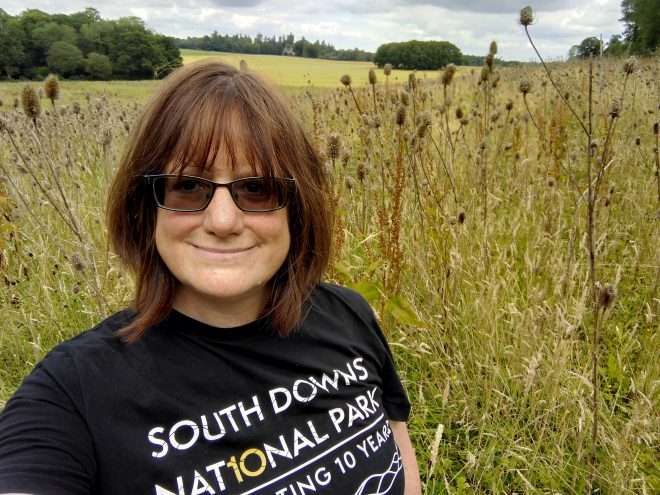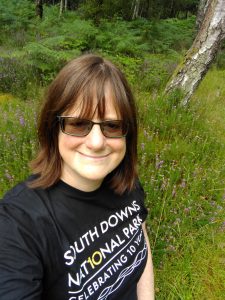Meet the South Downs National Park’s community climate champion!
September 9, 2024

While this summer has seen some very mixed conditions on the south coast of England, meteorologists say that 2024 is the warmest on the planet ever recorded.
There’s no doubt that our climate is becoming more unpredictable and taking positive climate action through nature-based solutions remains one of the National Park’s key priorities.
We chat with Sara Osman, the National Park’s new Climate Officer.
Why is climate change happening?
To quote the Met Office, which provides clear and simple information around climate change: “Climate change is the long-term shift in average weather patterns across the world. Since the mid-1800s, humans have contributed to the release of carbon dioxide and other greenhouse gases into the air. This causes global temperatures to rise, resulting in long-term changes to the climate.”. Unfortunately, we are continuously adding more gases into the atmosphere and they last there for many years. This is leading to what is known as the ‘greenhouse effect’, by trapping more heat in the atmosphere which effects the earth’s processes to maintain steady, predictable global temperatures.
What is the impact of climate change?
Evidence has shown that the high levels of greenhouse gases in the atmosphere are the leading cause of increasing global air and ocean temperatures. Since the Industrial Revolution, the average temperature of the planet has risen by around 1°C, and in 2023 global temperatures exceeded 1.5°C above pre-industrial times. This may not sound like much, but the impacts are enormous. Areas around the world that were typically covered by ice all year round are now seeing unprecedented areas without ice. This melting ice is leading to increase in sea level, which, for some areas of the world, is causing more flooding of coastal areas. We are also seeing greater wave height which means when there are storms, we get more coastal damage due to the bigger waves. The warming seas and sea level rise lead to a change in weather patterns around the world, as more water is evaporated from the warmer seas, and form larger clouds and bigger, more intense storms.
Here in the UK, climate projections show that we should expect to see:
- warmer and wetter winters
- hotter and drier summers
- more frequent and intense weather extremes.
This has an impact on the biodiversity of plants and animals and insects. Changing annual temperature affects the breeding cycle for animals and insects, and heat stress and flooding effects the plants that provide food for those animals and insects. Other impacts from climate change include health, food production, travel and transport.
What is the National Park doing in terms of climate action?
We’re committed to addressing the climate and nature emergencies by reaching ‘Net Zero’, both in how we run our organisation and also how we can influence emissions produced across the national park, from homes, businesses and transport etc. You can read more about what we mean by ‘net zero’ on our website
We have developed a Climate Change Strategy and Action Plan to explain our commitments and how we aim to reach ‘net zero’. This includes actions to work with local authorities across the National Park area, actions to deliver climate action through the planning system and actions to work with local communities to deliver climate action. Two key projects we have supported recently are Petersfield Climate Action Network, which ran a SuperHomes project to improve home energy efficiency, and Winchester Action on Climate Change, which supported 16 communities in the Winchester district to run events and activities that tackle climate change in their local areas.
What does you job involve then Sara?

My work focusses on two main areas. I support a funded project which aims to map all the climate action plans across local authorities in the national park and link them to the outcomes in the South Downs National Park Climate Action Plan. We will use this project to demonstrate the level of work going on to deliver action to tackle climate change, and also identify opportunities for smarter working. The other part of my role is to support community action on climate change and help share best practice so community groups can work together to develop projects that will address climate change at a local level. My work supports that of the Climate Change Lead, who focusses on strategic planning and carbon accounting.
Why is climate action important?
If global temperatures continue to exceed 1.5°C above pre-industrial levels, and edges towards 2°C increase, we will reach what are called ‘tipping points’ where it is difficult to reverse the impacts of climate change.
How we travel, how we heat our homes, what we buy and what we eat can all have an impact on climate change. By joining together with others in our community we can have an even bigger impact. From learning more about climate change, what the impacts are and what we can do to make a difference… to creating solutions in our communities, from car sharing to setting up repair cafes.
Coming together to deliver climate action locally will make the difference that we need to ensure the next generation inherit a more sustainable world.
Later this autumn we’ll be announcing some key initiatives on how local communities can get involved in climate action, so watch this space!
